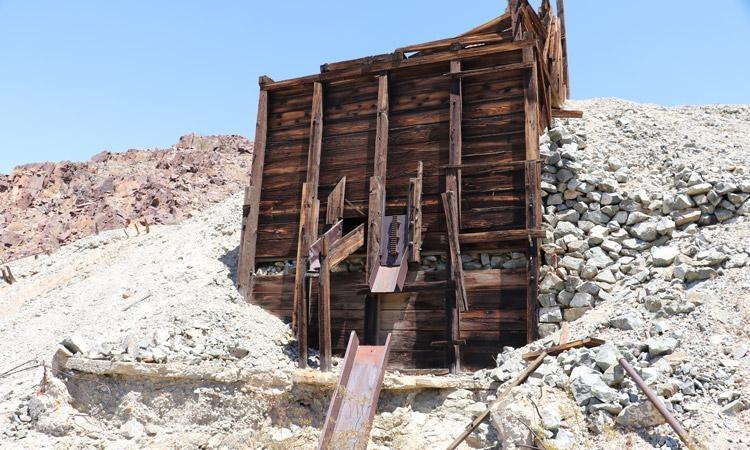Deep In Abandoned Gold Mines: A Toxic Legacy

Table of Contents
Environmental Contamination from Abandoned Gold Mines
Abandoned gold mines represent a major source of environmental contamination, poisoning surrounding ecosystems for decades, even centuries. The toxic legacy of these sites extends far beyond their physical boundaries, impacting water sources, soil quality, and the very air we breathe.
Water Pollution
Acid mine drainage (AMD) is a primary culprit. When sulfide minerals, commonly found in gold ore, are exposed to air and water, they oxidize, producing sulfuric acid. This acidic runoff leaches heavy metals like arsenic, mercury, lead, and cadmium from the mine waste, contaminating nearby waterways. The resulting water pollution severely harms aquatic life, rendering water sources unsafe for human consumption and agricultural use.
- Examples: The abandoned gold mines of California’s Sierra Nevada mountains and Romania’s Apuseni Mountains have both contributed to significant water pollution incidents.
- Long-term effects:
- Loss of biodiversity
- Disruption of aquatic ecosystems
- Contamination of drinking water supplies
- Harm to human health through consumption of contaminated fish and water
Soil Degradation
Mining activities drastically alter the physical and chemical properties of the soil. The removal of topsoil, the creation of unstable slopes, and the accumulation of heavy metals render the land barren and unproductive. This soil degradation leads to increased erosion, landslides, and reduced agricultural potential. The presence of heavy metals also poses a significant risk to plant life, preventing growth and potentially entering the food chain.
- Impact on agriculture: Contaminated soil can render farmland unusable, affecting food security and livelihoods in nearby communities.
- Remediation methods:
- Phytoremediation (using plants to remove contaminants)
- Bioremediation (using microorganisms to break down pollutants)
- Soil washing and stabilization
- Excavation and disposal of heavily contaminated soil
Air Pollution
Abandoned gold mines are not only a source of water and soil contamination, but also air pollution. Wind erosion can disperse dust particles containing heavy metals, leading to respiratory problems in nearby communities. Furthermore, abandoned mine shafts can release methane and other harmful gases, posing additional health risks.
- Airborne heavy metals: Inhalation of dust containing arsenic, lead, and other heavy metals can cause serious lung diseases.
- Methane gas: Methane emissions from abandoned mines contribute to greenhouse gas emissions and can pose an explosion hazard.
- Potential for long-term respiratory problems: Chronic exposure to airborne pollutants from abandoned gold mines can lead to asthma, bronchitis, and other respiratory illnesses.
Health Risks Associated with Abandoned Gold Mines
The toxic legacy of abandoned gold mines extends far beyond the environmental impact, posing serious and often long-term health risks to nearby communities.
Direct Exposure to Toxins
Direct contact with abandoned gold mines can lead to severe health consequences. Entering unstable mine shafts carries the risk of collapse and injury. Exposure to heavy metals and other toxins through inhalation, ingestion, or skin contact can result in various health problems.
- Dangers of entering abandoned mines: Collapsing shafts, hazardous gases, and unstable structures create extremely dangerous conditions.
- Potential health issues:
- Lead poisoning
- Mercury poisoning
- Respiratory illnesses
- Skin lesions
- Neurological damage
Indirect Exposure to Contamination
Even without direct contact with the mines, communities can experience significant health problems due to indirect exposure to contamination. Consuming contaminated water or food grown in polluted soil can lead to chronic health issues. Long-term exposure to low levels of toxins can have cumulative effects, making diagnosis challenging.
- Contaminated food chain: Heavy metals can accumulate in plants and animals, entering the human food chain.
- Long-term health consequences: Chronic exposure to low levels of toxins can manifest in various health problems years later.
- Challenges in diagnosis: The link between health problems and mine contamination is often difficult to establish.
Remediation and Mitigation Strategies for Abandoned Gold Mines
Addressing the toxic legacy of abandoned gold mines requires a multi-pronged approach focusing on both remediation and prevention.
Remediation Techniques
Various techniques exist to remediate contaminated water, soil, and air. These include passive and active treatment systems for AMD mitigation, phytoremediation, bioremediation, and excavation and disposal of heavily contaminated materials.
- Passive treatment systems: Utilize natural processes to treat contaminated water.
- Active treatment systems: Employ engineered systems to remove contaminants from water.
- Phytoremediation advantages: Cost-effective and environmentally friendly.
- Bioremediation advantages: Natural process, less disruptive than excavation.
Prevention and Regulation
Preventing future contamination is crucial. Stricter regulations for active and abandoned mines, coupled with thorough environmental impact assessments and responsible mining practices, are essential. Long-term mine closure planning, encompassing comprehensive environmental monitoring and remediation strategies, must be mandated.
- Stricter regulations: Enforce environmental standards throughout the mining lifecycle.
- Environmental impact assessments: Thoroughly evaluate the potential environmental consequences before mining begins.
- Responsible mining practices: Prioritize environmental protection and sustainable resource management.
Conclusion
Abandoned gold mines represent a stark reminder of the devastating environmental and health consequences of irresponsible resource extraction. The toxic legacy of gold mining pollution impacts communities and ecosystems for generations, necessitating urgent action. The key takeaways are the severe water and soil contamination, the significant health risks, and the necessity for both remediation efforts and proactive prevention. Let's work together to mitigate the toxic legacy of abandoned gold mines through stricter regulations, responsible mining practices, and the implementation of effective remediation strategies. To learn more and support relevant initiatives, visit [link to relevant organization 1] and [link to relevant organization 2].

Featured Posts
-
 How Margin Pressure Is Affecting Westpac Wbc Profits
May 06, 2025
How Margin Pressure Is Affecting Westpac Wbc Profits
May 06, 2025 -
 Millions Stolen Insider Reveals Office365 Breach And Executive Targeting
May 06, 2025
Millions Stolen Insider Reveals Office365 Breach And Executive Targeting
May 06, 2025 -
 Magnitogorskaya Aktrisa Alina Voskresenskaya V Seriale Univer Molodye Na Tnt
May 06, 2025
Magnitogorskaya Aktrisa Alina Voskresenskaya V Seriale Univer Molodye Na Tnt
May 06, 2025 -
 Celtics Vs Knicks Playoff Game 1 Predictions And Betting Analysis
May 06, 2025
Celtics Vs Knicks Playoff Game 1 Predictions And Betting Analysis
May 06, 2025 -
 Discover The Countrys Fastest Growing Business Hubs
May 06, 2025
Discover The Countrys Fastest Growing Business Hubs
May 06, 2025
Latest Posts
-
 Anticipating The Met Gala 2025 Early Predictions For The Guest List
May 06, 2025
Anticipating The Met Gala 2025 Early Predictions For The Guest List
May 06, 2025 -
 Speculation Mounts Potential Met Gala 2025 Guest List And Celebrity Attendees
May 06, 2025
Speculation Mounts Potential Met Gala 2025 Guest List And Celebrity Attendees
May 06, 2025 -
 Watch Beauty School Achieving And Maintaining Extra Long Nails
May 06, 2025
Watch Beauty School Achieving And Maintaining Extra Long Nails
May 06, 2025 -
 Predicted Met Gala 2025 Guest List A List Celebrities And More
May 06, 2025
Predicted Met Gala 2025 Guest List A List Celebrities And More
May 06, 2025 -
 The Art Of Extra Long Nails A Beauty School Tutorial
May 06, 2025
The Art Of Extra Long Nails A Beauty School Tutorial
May 06, 2025
